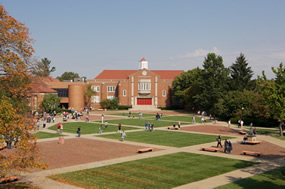
Recently the news has offered ongoing reporting of the challenges facing Ohio colleges and universities as a result of the recent COVID-19 outbreak. This post will begin a series exploring the effects of the pandemic on Ohio colleges and examining the choices they are making.
As you know, campuses across Ohio and the U.S. closed in March, sending students home to shelter in place while completing classes online. In the meantime, college campuses went quiet. residence halls were vacated, meal service halted, college sporting events cancelled, and bookstores closed. With little choice in the matter, colleges partially refunded residence hall and meal plan fees while retaining tuition income already paid by students in or around the beginning of the year. So, as the winds of change blew across campus, colleges were faced with budgetary as well as teaching-and-learning challenges. Additionally, they faced a set of high stakes next-step challenges and choices shrouded in uncertainty.
This post will dive a little deeper into the budgetary challenges posed by the pandemic and its fallout. The next post will explore teaching and learning challenges. Then we will look at college recruitment amid the crisis. Then we will dive into the choices colleges are trying to make as they prepare for fall.
Budgetary Challenges
One way to look at this is to consider that a college is actually multiple businesses in one. Unfortunately most of their businesses are not corona-virus friendly.
First, they are in the “hotel business.” They provide rooms, housekeeping, laundry services, and educational and social programming to large numbers of students living on campus. These enterprises employ residence hall directors, housekeepers, grounds keepers, and other service providers. Many, if not most, of these residence halls are supported by loans required to build them. Banks over the years have been particularly amenable to loaning money for residence halls as they have a captive student population and virtually guaranteed full occupancy.
Surprise! Students have just vanished, and related revenue had to be refunded. However, loan payments still must be paid, grounds and buildings still must be maintained, utilities must be paid, and staff retained as possible and/or necessary.
Next, they are in the “restaurant business.” Colleges provide ongoing food service to residence hall coffee shops, to faculty dining rooms, to special events, to large student dining halls, to concessions at sporting events – the list goes on. Many colleges contract with meal service providers but others take this on themselves. Even the majority who contract with others are still on the hook for some mix of shared costs. Of course they are fully responsible for all the bricks-and-mortar involved and, once again, many of these vast dining and meeting facilities are significantly mortgaged and require bills to be paid, spaces to be maintained, exterior grounds to be kept up and so forth. So, once again these facilities are now empty and colleges have partially refunded meal plan revenues while continuing to have to pay for all there related costs.
Are you getting the idea now?
They are also in the “athletics and fitness business.” The exorbitant cost of building and maintaining athletic facilities, stadiums, pools, tracks, gyms, and fitness facilities are also often undergirded by debt that is typically offset by ticket revenues, student fees, concessions, and donations. Large numbers of coaches, assistant coaches, fitness staff, campus life programmers, trainers, and others also must be paid. Since athletic programs are significant forms of student recruitment simply reducing staff is not without consequences.
Surely you are getting the idea now. I could go on and suggest that colleges are in the “medical and healthcare business” and discuss costs associated with their health centers and counseling centers. I could argue that they are also in the “social programming (entertainment) business” and discuss the costs associated with managing fraternities, sororities, and other student organizations. Not to mention, student activities and events. Once again we have costs associated with debt, staff, and facilities.
Wait…what about the fact that tuition was paid and the colleges got to keep that?
At last, a bright side…sort of. It’s true that most colleges were able to retain collected tuition. It was also fortunate that most colleges utilize the same sophisticated learning software to support both face-to-face classes and online classes. Thus most faculty were already using online learning software even if they weren’t teaching online. The conversation however was not without costs and challenges. Faculty had to be trained or find ways to learn how to deliver their classes online and there was little or no time to practice or explore how best to transition their content to an online format. The result was mixed – some faculty transitioned effectively and others struggled. As a result the student online experience was spotty to say the least. All-the-while colleges had salaries to pay, new training costs to absorb, and new virtual technologies to navigate.
The Result
As might be anticipated, the result was budgetarily catastrophic. Revenues plummeted while costs were only minimally changed. With revenues going through the floor colleges had to pivot to online learning. They cut costs across the board, furloughed or terminated employees where possible, and many even worked to renegotiate loans and otherwise reduce costs. Colleges with large endowments (savings accounts) initiated withdrawls while others, particularly small private colleges with small endowments and lots of debt, found themselves on the ropes. As if this wasn’t enough, they still had to find a way to recruit next year’s class against a backdrop of campus tour cancellations and campus closings.
The Worst May be Yet to Come
At this point, Ohio has already lost one private college – Urbana University, part of Franklin University, closed its doors in May and will not reopen. Valiant and creative efforts by their acting president, Christopher Washington, and tireless efforts of a game faculty and staff were simply not enough. Already Urbana University was a turn-around effort that was simply derailed by a pandemic they never expected.
I believe there will be more to come. Those institutions that have found themselves struggling mightily face an uncertain fall and, most likely, a reduced freshman class. Of course, the most daunting possibility is the possibility that they might not be able to open campus or, might have to close it again in the event of a spike in infections. Even the healthiest colleges and universities, including the public 4-year institutions are struggling as well albeit in a less life-threatening way.
Too Much Doom and Gloom?
So much for bad news. Most Ohio colleges will retrench, adapt, and respond creatively enough to survive and, at some point, thrive again. Unfortunately it is still raining and the storm clouds still surround us. So, in my next entry, we will dive a bit more deeply into the teaching and learning side of the current situation.
About the Author: After touring 60 of the best colleges in Ohio and exploring the myriad of majors, minors, certificates, and workforce development programs in the state, Dr. Jay, a prior faculty member and dean, founded College Bound Advantage (CBA) – a Columbus, Ohio college consulting firm. CBA specializes in helping families optimize college selection around 18 “fit factors” and helping students clarify co-curricular and major options while exploring colleges that specialize in them. CBA also specializes in helping students who want to explore non-traditional educational options that do not require a 4-year college degree. Finally, CBA works with students who started college, but found that, for any number of reasons, it was not for them. College Bound Advantage serves all of Ohio including Cleveland, Akron, and Cincinnati metro areas. Check us out at www.collegeboundadvantage.com or check out what we can do for you here: https://www.youtube.com/watch?v=J6SSjHp8n98

































































